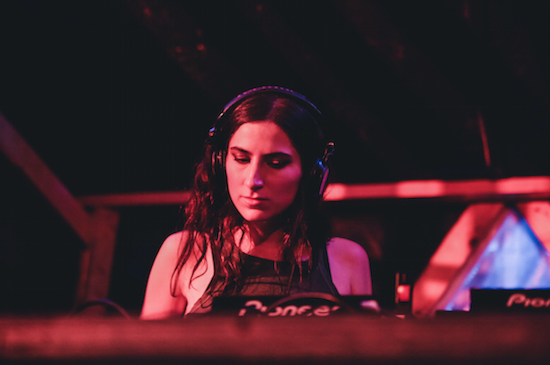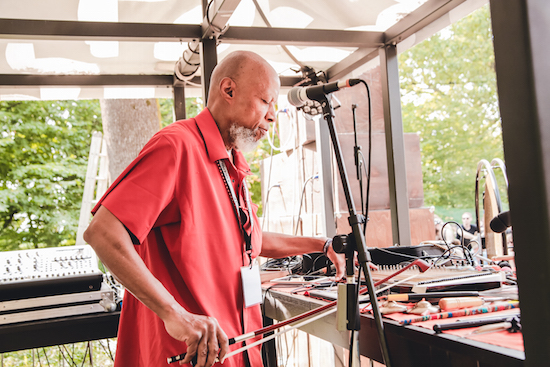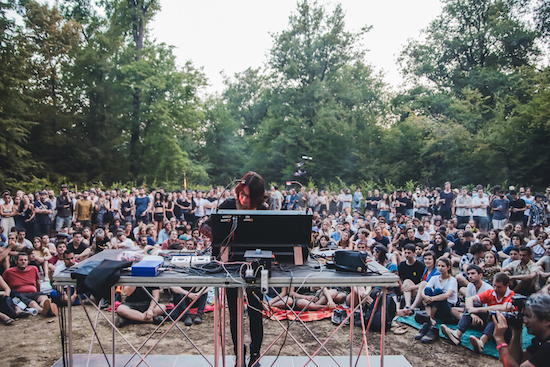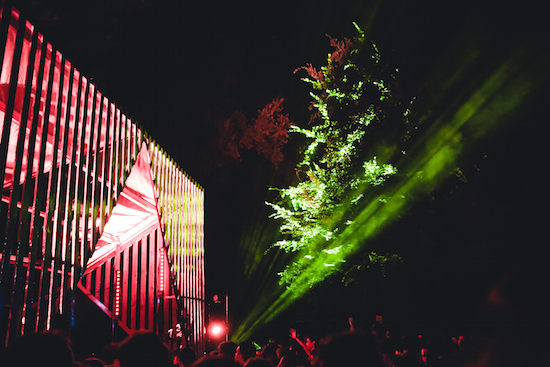All photos courtesy of Michela Di Savino
There are no headline acts at Terraforma. Instead there are equally billed artists, scheduled not in order of their perceived popularity but in terms of when their music will have the most impact on the festival audience. This shouldn’t be such a novel idea, but it fails or is even totally ignored as a concept elsewhere. It seems to work at Terraforma because it’s part of their wider worldview, where sustainability and community are of primary importance, where intimate workshops and a DIY feel connect an experimental electronic lineup.
Location is everything
Earlier this year I watched on from the side of one of Berlin’s HAU venues as Stine Janvin played as part of the city’s <a href=“http://thequietus.com/articles/21829-ctm-festival-berlin-2017-pan-daijing-sote-gazelle-twin-pharmakon" target=“new”>CTM Festival. The performance was far from incandescent – the looped, reverberating vocals seemed to be lack something important – but on the opening night of Terraforma in the quad sound set-up of one of festival’s smallest spaces, Janvin’s work acquires a new sense of life. She ricochets off the humid air in a way that reminds us that all things, even those we can’t see, are present at all times. The waxing and waning of her voice, anxiously bouncing around in the almost-freedom of the open air, suggests something profoundly natural – ancient patterns and modern traumas.
Absence doesn’t necessarily make the heart grow fonder, and that works both ways
The return of Wolfgang Voigt’s GAS project <a href=“http://thequietus.com/" target=“new”>after 20 years is a big deal. I know this because I have read it in PR materials and, very occasionally, seen it written by people I know on Facebook. But being a big deal doesn’t make it a good thing. Even in the presence of a small and undoubtedly dedicated crowd of GAS fans at Terraforma, the project seems at odds with its surroundings, its self and the world as a whole. Something about the performance just sits wrong; perhaps it is something like a deficit of joy a sense that GAS for the sake of GAS is not necessarily better than no GAS at all.

Contrast this with Aurora Halal’s set later the same night and the lines are drawn even more sharply. The Brooklyn-based DJ, producer, artist and Sustain-Release promoter is the antithesis of the fug of Wolfgang Voigt: for two hours, her selections are streamlined and severe, providing a consistent pummelling as well as an intoxicating call to action. There’s a real sense of catharsis and, if you’ll forgive me, a true sustain-release.
Maybe ‘new age’ isn’t a synonym for bullshit
This little tidbit comes courtesy of Laraaji, his zither, and a bit of gong-ringing. The seventysomething American multi-instrumentalist combines elements of drone, ambient music and the decidedly new age to cultivate a set that is more than the sum of its parts. It is, if you were wondering, possible to both zoom in on something completely and zone out from everything else entirely. Somewhere between his own infectious attitude to life and the sounds he creates, Laraaji creates a peculiar sense of freedom.

Suzanne Ciani is the absolute boss
If you know who Suzanne Ciani is, this piece of information will not be a surprise to you. A pioneer of synth, contemporary electronic music and sound design as much broader subjects, we’ve all heard her work whether it’s her music created for Atari or Coca-Cola’s pop and pour. She’s in her element at Terraforma, surrounded by the quad sound she prizes so dearly and by people who want nothing more to marvel at the complexity of a live analogue synth show — to glimpse those leads and knobs, all those manual sequences — to see the wizard behind the curtain of electronic music.
Her performance is more than pure spectacle, though: the ethereal quality of her music, the aural equivalent of the last pirouettes of sunlight on water, is both immersive and submersive. It’s impossible to escape from, and it gives you no reason to want to. Then, with all all those sockets and switches, it gets a little too much for the festival’s power supply and for a few golden minutes Terraforma is draped in nothing but silence and the setting sun; it feels as utterly beautiful and as entirely seamless as any of Ciani’s intended transitions.

Home is where the heart is, but you can take it anywhere
On the one hand, there’s something about finding a little slice of London in the midst of a Mediterranean paradise that conjures images of the Costa Del Sol. On the other, there is an undeniable sense of comfort in familiarity. And familiarity can be challenging – watching Mala play truly filthy dubstep, with the backdrop of Villa Arconati and its surrounds, accompanied by a chorus of cicadas, on Saturday night is a moving experience. The set, which takes minor detours through subroutes of the genre, through bass and percussion, squeals and ticks, is transportive and somehow wholly fitting for the occasion. It’s a sensory overload that, for all its strange juxtapositions, seems perfectly apt for this wonderful and peculiar festival.


